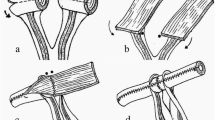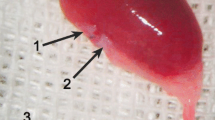Abstract
Background
Long-segment ureteral injuries may have different etiologies. Although multiple procedures have been previously used for ureteral replacement, none of them had optimum results, and replacement of long segments of injured ureter is still a challenging surgical problem. In this article, we have hypothesized that it may be possible to use intestinal seromuscular tunneling as a novel method for ureteral replacement.
Methods
This experimental study was conducted on eight dogs. After cutting the ureter at about its mid-part and ligating the distal part, a 10-cm tunnel was made in the seromuscular layer of small intestine using a metallic probe, and a catheter was passed through it. Proximal and distal ends of the tunnel were anastomosed to proximal end of ureter and urinary bladder, respectively. After 8 weeks, the dogs were killed, and their whole urinary system was sent for histopathologic examinations.
Results
No complication was noted during the post-op period. Histopathologic examinations confirmed that the seromuscular tunnel was well patent, lined by pseudostratified transitional epithelium and without any inflammatory reaction.
Conclusion
Our study shows that ureteral replacement by intestinal seromuscular tunneling is anatomically possible at least in animal model. However, more well-designed prospective studies are needed to confirm its long-term functional results.




Similar content being viewed by others
References
Singh I, Strandhoy JW, Assimos DG, et al (2012) Upper urinary tract obstruction and trauma. In Wein AJ, Kavoussi LR, Novick AC, et al (eds) Campbell-Walsh urology, 10th edn. Elsevier, Philadelphia vol 2, Section IX, pp 1085–1190
Armatys SA, Mellon MJ, Beck SD et al (2009) Use of ileum as ureteral replacement in urological reconstruction. J Urol 181(1):177
Chung BI, Hamawy KJ, Zinman LN et al (2006) The use of bowel for ureteral replacement for complex ureteral reconstruction: long-term results. J Urol 175(1):179
Boxer RJ, Fritzsche P, Skinner DG et al (1979) Replacement of the ureter by small intestine: clinical application and results of the ileal ureter in 89 patients. J Urol 121(6):728
Austen M, Kälble T (2004) Secondary malignancies in different forms of urinary diversion using isolated gut. J Urol 172(3):831
Sabanegh ES Jr, Downey JR, Sago AL (1996) Long-segment ureteral replacement with expanded polytetrafluoroethylene grafts. Urology 48(2):312
Varady S, Friedman E, Yap WT et al (1982) Ureteral replacement with a new synthetic material: Gore-Tex. J Urol 128(1):171
Peters JJ, Shingleton WB, Morgan D et al (1996) Neointimized Gore-Tex graft for ureteral prosthesis in the dog. Urology 48(3):379
Baltaci S, Ozer G, Ozer E et al (1998) Failure of ureteral replacement with Gore-Tex tube grafts. Urology 51(3):400
Smith TG 3rd, Gettman M, Lindberg G et al (2002) Ureteral replacement using porcine small intestine submucosa in a porcine model. Urology 60(5):931
Liatsikos EN, Dinlenc CZ, Kapoor R et al (2001) Ureteral reconstruction: small intestine submucosa for the management of strictures and defects of the upper third of the ureter. J Urol 165(5):1719
Duchene DA, Jacomides L, Ogan K et al (2004) Ureteral replacement using small-intestinal submucosa and a collagen inhibitor in a porcine model. J Endourol 18(5):507
El-Assmy A, Hafez AT, El-Sherbiny MT et al (2004) Use of single layer small intestinal submucosa for long segment ureteral replacement: a pilot study. J Urol 171(5):1939
Sofer M, Rowe E, Forder DM et al (2002) Ureteral segmental replacement using multilayer porcine small-intestinal submucosa. J Endourol 16(1):27
Dahms SE, Piechota HJ, Nunes L et al (1997) Free ureteral replacement in rats: regeneration of ureteral wall components in the acellular matrix graft. Urology 50(5):818
Tachibana M, Nagamatsu GR, Addonizio JC (1985) Ureteral replacement using collagen sponge tube grafts. J Urol 133(5):866
Osman Y, Shokeir A, Gabr M et al (2004) Canine ureteral replacement with long acellular matrix tube: is it clinically applicable? J Urol 172(3):1151
Hodjati H, Kazemi K, Jalaeian H et al (2008) Tracheal reconstruction by esophageal submuscular tunneling: an experimental study. J Surg Res 150(1):74
Harzmann R, Kopper B, Carl P (1986) Cancer induction by urinary drainage or diversion through intestinal segments? Urologe A 25(4):198
Acknowledgments
This article is based on the thesis of Dr. Jalal Khalili Paidar for finishing general surgery residency and financially supported by Shiraz University of Medical Sciences (Grant Number 90-01-01-4181).
Author information
Authors and Affiliations
Corresponding author
Rights and permissions
About this article
Cite this article
Hodjati, H., Paidar, J.K., Kumar, P.V. et al. Intestinal seromuscular tunneling: a novel method for ureteral replacement—an experimental design. Int Urol Nephrol 47, 1351–1355 (2015). https://doi.org/10.1007/s11255-015-1027-8
Received:
Accepted:
Published:
Issue Date:
DOI: https://doi.org/10.1007/s11255-015-1027-8




